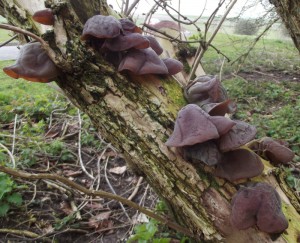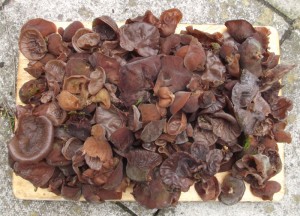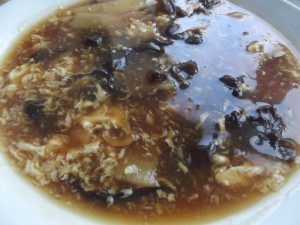13/04/2013
At least nobody is going to argue about its latin name! In this case, the latin name was derived from an English common name that predates it (Judas’ ear) and which is still in common usage in the slightly altered form of “Jew’s ear.”
There has recently been an attempt to change this common name. In 2003 the British Mycological Society published a new list of common names for fungi, and in most cases the motivation where there was a new (or newly “official”) name was either to provide a common name for species that had none or to select one common name for species that had several. Where possible there was also an attempt to make them more taxonomically consistent, although this has only been partially successful due to many changes in latin names due to advances in our understanding of fungal taxonomy as a result of widespread genetic testing. This species was a special case, because it was the only one where the motivation was that of political correctness, the claim being that “Jew’s ear” is anti-Semitic. My own view concurs with that of mycologist Patrick Harding – that this an abuse of the English language and that the BMS should be concerned with fungi, not politics, religion or the evolution of the English language. I see no reason to believe this has anything to do with anti-Semitism. Judas Iscariot was a Jew, and the mythology in question is an integral part of the Christian religion – this species is found most frequently on elder trees, either dead or alive, and it was an elder tree from which Judas supposedly hung himself. If this is going to be considered anti-Semitic then the whole Christian religion must be considered anti-Semitic. This it may be, but it is not the place of the BMS to get involved in such issues. If people have a problem with the anti-Semitic nature and history of Christianity, then I suggest they take it up with their local church, or maybe the Archbishop of Canterbury. I shall continue to call this fungus “Jew’s ear.” If other people want to call it “jelly ear” then that’s up to them.
The naming situation is further complicated by the fact that although this particular species has never been widely consumed in its home territory of northern Europe, it has a close relative which is an important culinary and medicinal species in several south-east Asian countries, especially China. Auricularia polytricha, known in China as “wood ear” or “cloud ear”, and in Japan as kikurage or “tree jellyfish”, is taxonomically distinct, but there is no important difference from a culinary or medicinal point of view.
Jew’s ear is very common and can sometimes be found in vast quantities. One of those times is right now, at least in my home territory of Sussex. This is the second fruiting of this year. I found quite a bit of it around Christmas and New Year, but haven’t seen much of it since then, until two days ago, when I found this lot. Plenty more were coming through, so I decided to pick a large bagful and experiment with it, there being very little else in the way of edible fungi available right now (though this is going to change in the very near future when the warmer weather finally arrives from tomorrow onwards.) There are no similar poisonous species, so this one is reasonably safe for beginners to collect (although not entirely foolproof – I saw somebody get it wrong on the internet last year.)
And experimentation may well be required if you’re going to do anything culinary with it. I’m not going to provide any recipes here, but I can point readers in the general direction of two culinary uses.
The first comes from Roger Phillips’ seminal book “Wild Food.” That book contains a recipe for Jew’s ear rolls, which are basically “swiss rolls” made from soft, sliced white bread with a jew’s ear, garlic and herb filling. It took me several attempts to get this recipe right. The fungus has to be cooked on a very low heat for at least twenty minutes. If the heat is too high then the garlic will burn and the fungus is likely to explode and end up all over your kitchen walls – or in your eyes, so watch out. If it is not cooked for long enough then it will be too rubbery. And you have to use the right sort of bread or the rolls won’t roll properly. Once you have got to the stage of getting the rolls rolled, and staked with a cocktail stick, then they can be coated with butter and placed in an oven to brown. I finally got the recipe to work at the third attempt, and was very pleased with the result.
The second is the most common traditional usage from Asian cooking, and that is hot and sour soup. I’m not going to recommend any particular recipe because I’m no expert on Chinese food and there are literally hundreds of versions of hot and sour soup. It is an entire genre rather than a specific dish. I was pleasantly surprised by the version I cobbled together yesterday, which involved bamboo shoots, chicken stock, fresh ginger, red wine vinegar, dark soy sauce and a beaten egg.
Anyway, if you want to try foraging for this species, now is a good time to go looking.



